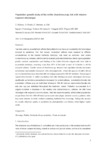Mostrar o rexistro simple do ítem
Population growth study of the rotifer Brachionus sp. fed with triazine-exposed microalgae
| dc.contributor.author | Rioboo, Carmen | |
| dc.contributor.author | Prado, Raquel | |
| dc.contributor.author | Herrero, Concepción | |
| dc.contributor.author | Cid, Ángeles | |
| dc.date.accessioned | 2014-09-09T10:20:54Z | |
| dc.date.available | 2014-09-09T10:20:54Z | |
| dc.date.issued | 2007-08 | |
| dc.identifier.citation | Rioboo C, Prado R, Herrero C, Cid A. Population growth study of the rotifer Brachionus sp. fed with triazine-exposed microalgae. Aquatic Toxicology. 2007;83(4):247-53 | es_ES |
| dc.identifier.uri | http://hdl.handle.net/2183/12496 | |
| dc.description.abstract | [Abstract]Few data exist on potential toxic effects that pollutants may have on zooplankton fed microalgae exposed to pesticides. For that reason, microalgal cultures were exposed to different concentrations of the triazine herbicide terbutryn, and used as exclusive food source to Brachionus sp. females, with the aim to evaluate potential deleterious effects upon population growth, survival, reproduction and feeding of the rotifer.Chlorella vulgaris cells were able to accumulate terbutryn, removing more than 90% of the total amount of herbicide in all the exposed cultures. Growth curves of Brachionus sp. showed that population density decreased as terbutryn concentration increased in the microalgal cells. In fact, this species of rotifer did not survive beyond four days when fed with microalgae exposed to 500 nM terbutryn. Percentage of reproductive females in rotifer populations fed with terbutryn-exposed microalgae decreased significantly as herbicide concentration increased. In control cultures, reproductive females laid a maximum of three eggs per individual; whereas in 100 nM cultures, reproductive females laid only one egg per individual throughout the treatment period. Terbutryn accumulated in C. vulgaris provoked a decrease in the feeding rate ofBrachionus sp. cultures fed with these microalgae with respect to control cultures. After this treatment period, all the rotifer populations, except those fed with 500 nM terbutryn-exposed microalgae, showed recovery patterns when they were returned to fresh medium containing herbicide-free microalga. Taking into account the results obtained, uptake of pesticides by phytoplankton can directly affect higher trophic levels. | es_ES |
| dc.description.sponsorship | Xunta de Galicia; PGIDIT04RFO103946PR | es_ES |
| dc.language.iso | eng | es_ES |
| dc.relation.uri | http://dx.doi.org/10.1016/j.aquatox.2007.04.006 | es_ES |
| dc.subject | Bioaccumulation | es_ES |
| dc.subject | Pesticide transfer | es_ES |
| dc.subject | Microalga | es_ES |
| dc.subject | Rotifer | es_ES |
| dc.subject | Herbicide | es_ES |
| dc.title | Population growth study of the rotifer Brachionus sp. fed with triazine-exposed microalgae | es_ES |
| dc.type | info:eu-repo/semantics/article | es_ES |
| dc.rights.access | info:eu-repo/semantics/openAccess | es_ES |






